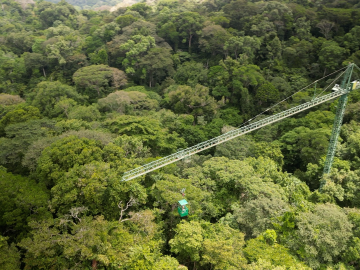
Filter News
Area of Research
- Advanced Manufacturing (2)
- Biology and Environment (39)
- Computational Biology (1)
- Computational Engineering (3)
- Computer Science (10)
- Electricity and Smart Grid (2)
- Energy Science (64)
- Functional Materials for Energy (1)
- Fusion and Fission (11)
- Fusion Energy (10)
- Isotopes (1)
- Materials (30)
- Materials for Computing (4)
- Mathematics (1)
- National Security (10)
- Neutron Science (15)
- Nuclear Science and Technology (6)
- Quantum information Science (5)
- Sensors and Controls (1)
- Supercomputing (47)
News Type
News Topics
- (-) Environment (99)
- (-) Fusion (28)
- (-) Grid (43)
- (-) Machine Learning (31)
- (-) Molten Salt (8)
- (-) Quantum Science (47)
- (-) Summit (32)
- 3-D Printing/Advanced Manufacturing (93)
- Advanced Reactors (27)
- Artificial Intelligence (62)
- Big Data (34)
- Bioenergy (46)
- Biology (51)
- Biomedical (32)
- Biotechnology (16)
- Buildings (43)
- Chemical Sciences (57)
- Clean Water (16)
- Composites (25)
- Computer Science (121)
- Coronavirus (28)
- Critical Materials (23)
- Cybersecurity (21)
- Education (3)
- Element Discovery (1)
- Emergency (2)
- Energy Storage (80)
- Exascale Computing (24)
- Fossil Energy (2)
- Frontier (25)
- High-Performance Computing (58)
- Hydropower (6)
- Irradiation (3)
- Isotopes (29)
- ITER (6)
- Materials (107)
- Materials Science (94)
- Mathematics (3)
- Mercury (5)
- Microelectronics (1)
- Microscopy (31)
- Nanotechnology (44)
- National Security (26)
- Neutron Science (88)
- Nuclear Energy (55)
- Partnerships (36)
- Physics (31)
- Polymers (24)
- Quantum Computing (21)
- Security (13)
- Simulation (24)
- Software (1)
- Space Exploration (13)
- Statistics (2)
- Transportation (73)
Media Contacts

Oak Ridge National Laboratory researchers are using a new bioderived material to 3D print custom roosting structures for endangered bats.

Plants the world over are absorbing about 31% more carbon dioxide than previously thought. The research, detailed in the journal Nature, is expected to improve Earth system simulations that scientists use to predict the future climate, and spotlights the importance of natural carbon sequestration for greenhouse gas mitigation.

Researchers led by the University of Melbourne, Australia, have been nominated for the Association for Computing Machinery’s 2024 Gordon Bell Prize in supercomputing for conducting a quantum molecular dynamics simulation 1,000 times greater in size and speed than any previous simulation of its kind.

ORNL researchers were honored with a prestigious ACE Award for Composites Excellence by the American Composites Manufacturers Association. The team won the “innovation in green composites design” prize for creating a fully recyclable, lightweight wind turbine blade tip that incorporates low-cost carbon fiber and conductive coating for enhanced protection against lightning strikes.

A new technology to continuously place individual atoms exactly where they are needed could lead to new materials for devices that address critical needs for the field of quantum computing and communication that cannot be produced by conventional means.

A study led by the Department of Energy’s Oak Ridge National Laboratory details how artificial intelligence researchers created an AI model to help identify new alloys used as shielding for housing fusion applications components in a nuclear reactor. The findings mark a major step towards improving nuclear fusion facilities.

A new technical collaboration program at the Department of Energy’s Oak Ridge National Laboratory will help businesses develop and launch electric grid innovations. Sponsored by the Transformer Resilience and Advanced Components program in DOE’s Office of Electricity, the initiative will provide companies with access to national laboratory resources, enabling them to capture market opportunities.

Scientists using high-resolution aerial scans and computational modeling concluded that wildfires, storms and selective logging have become key drivers behind rainforest carbon emissions, outpacing clear-cutting practices.

A team led by scientists at ORNL identified and demonstrated a method to process a plant-based material called nanocellulose that reduced energy needs by a whopping 21%, using simulations on the lab’s supercomputers and follow-on analysis.

ORNL is the lead partner on five research collaborations with private fusion companies in the 2024 cohort of the Innovation Network for FUSion Energy, or INFUSE, program. These collaborative projects are intended to resolve technical hurdles and develop enabling technologies to accelerate fusion energy research in the private sector.


